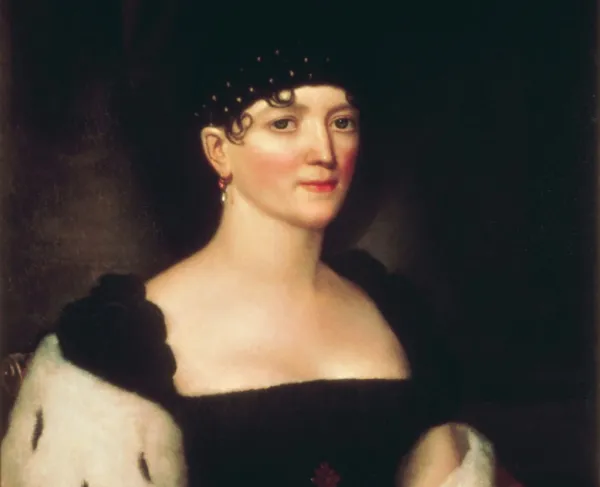Elizabeth Kortright Monroe

Elizabeth Kortright was born in New York on June 30, 1768, the youngest daughter of a wealthy old New York family. Her father, Lawrence Kortright, made a fortune privateering during the French and Indian War. When Elizabeth was 9 years old, her mother died during childbirth, and her father never remarried. During the Revolutionary War, Lawrence Kortright was a part owner of multiple privateer ships, but his fortunes suffered throughout the war. In October 1785—a few months before Elizabeth would married a Revolutionary War soldier and politician—her father petitioned George Washington for payment for the loss of his sloop Hester.
On February 16, 1786, Elizabeth married James Monroe. The two met in New York City while Monroe served in the Continental Congress. After Congress adjourned that spring, the couple moved from New York City to Fredericksburg, Virginia. This would have been a considerable adjustment for Elizabeth, who had lived her whole life in the bustle of the city. The couple moved around often early in their marriage because of Monroe’s political career. Elizabeth gave birth to two daughters and a son who died in infancy.
Elizabeth faced her biggest change when Washington appointed Monroe the American Minister to France in 1794. The family arrived in France at the height of the French Revolution. They had the delicate task of establishing the United States as a world power in the minds of the French while not offending the French revolutionary government. Elizabeth took to the task by learning French, immersing herself in French culture, mastering European etiquette, and sending her daughter to a French school. She earned the nickname la belle americaine from her French circle. Her charm and fashions made her very popular, thus increasing Monroe’s prestige as an ambassador.
Elizabeth utilized her popularity to save the life of Marie-Adreinne Lafayette, wife of the Marquis de Lafayette who had been a strong ally during the American Revolution. Madame Lafayette was imprisoned and scheduled to be executed by guillotine by French revolutionaries while her husband had been forced to flee the country. The Monroes wanted to save the wife of one of America’s most important allies during the war. Elizabeth requested a visit with Madame Lafayette in prison and embraced her in public. She successfully swayed the public opinion and secured Madame Lafayette’s release.
In the following years, Monroe secured different positions in government and as a diplomat abroad. Elizabeth stayed close with him whenever the family had to move, even during difficult times. While Monroe served as the Minister to England, the family did not receive the same level of respect and support as they did in France. While living in Virginia, the family occupied Oak Hill Plantation, inherited from James’s uncle. Enslaved people labored at the plantation, and Monroe owned more than 200 enslaved people during his lifetime.
Elizabeth became First Lady when her husband became President in 1817. Throughout the administration Elizabeth sought to increase the prestige of the White House by implementing European etiquette and a more formal atmosphere. This change was not well-accepted by Washington society, who were used to the egalitarian atmosphere of the White House under the Madisons. Elizabeth suffered with poor health for much of the administration, which prevented her from making social calls to the homes of senators and congressmen. This brought her more criticism from Washington’s elite, who boycotted the small number of parties that she hosted in the White House.
After leaving the White House, Elizabeth retired to their Oak Hill Plantation in Virginia. Elizabeth died at Oak Hill on September 23, 1830. Few of her personal papers remain, so we know little of her life from her own words.





